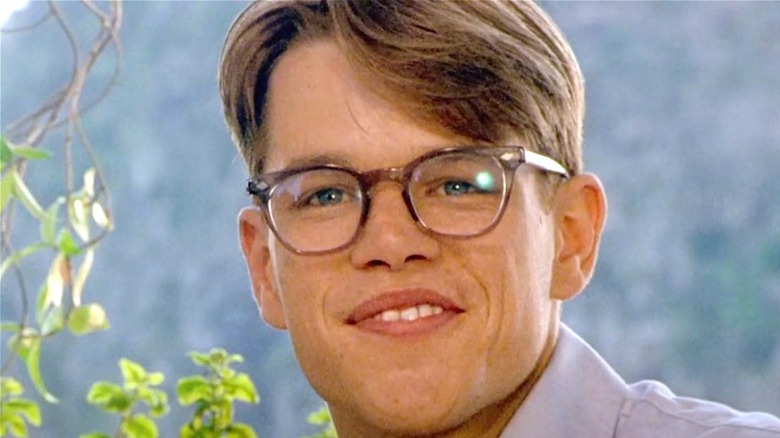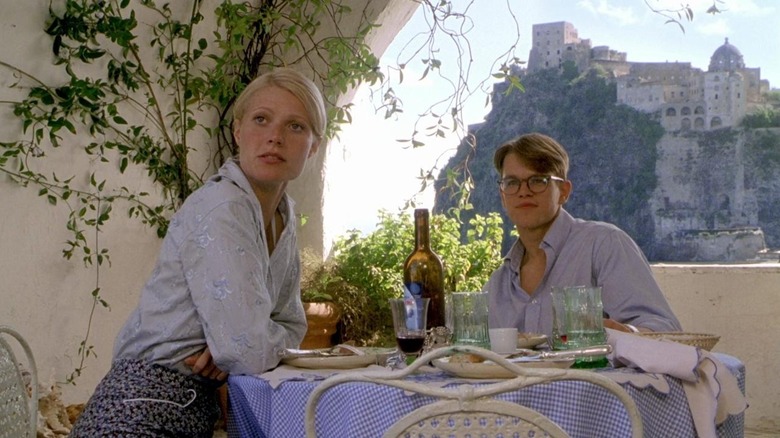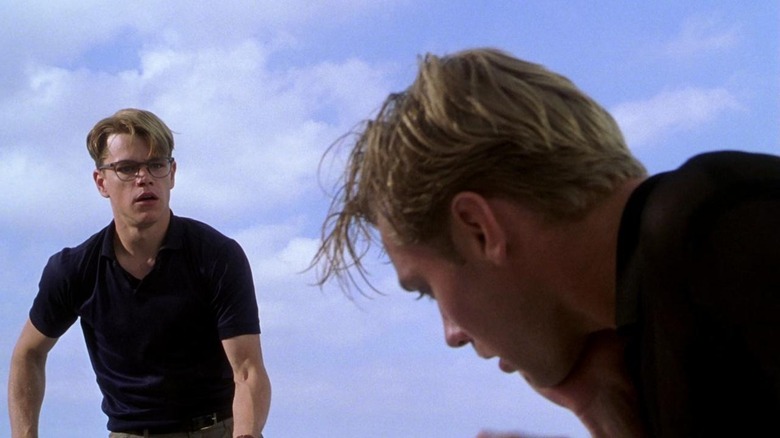How The Talented Mr. Ripley Differs From The Book
"The Talented Mr. Ripley," the psychological thriller starring Matt Damon as the titular Tom Ripley and directed by Anthony Minghella, has maintained its popularity since being released in 1999. It also contains some of the most memorable performances that three of its most prominent actors — Damon, Jude Law and Gwyneth Paltrow — have ever given.
The film follows a young man named Tom Ripley, who, after being mistaken for a Princeton alum and an acquaintance of Dickie Greenleaf (Law), is hired by Dickie's father, shipping magnate Herbert (James Rebhorn), to seek out Dickie in Italy and persuade him to return to the United States. After meeting Dickie, along with Dickie's girlfriend Marge Sherwood (Paltrow), Tom quickly becomes enamored with Dickie's lavish lifestyle. Tom becomes obsessed not only with Dickie's life, but with Dickie himself, ultimately resulting in Tom murdering Dickie when Dickie tries to part ways with Tom. Tom then decides to take over Dickie's life, determined to do whatever it takes to keep up the false identity. Dickie's murder soon ends up leading Tom to commit more murders to cover his tracks and save himself, up until the film's ending, in which Tom is all alone, knowing that he'll always be outrunning his actions.
The film is based on the 1955 novel of the same name by acclaimed American writer Patricia Highsmith. "The Talented Mr. Ripley" is generally regarded as being a well-executed book-to-movie adaptation, but of course, some changes had to be made to fit the medium. So, in what ways does the film incarnation of "The Talented Mr. Ripley" differ from the book?
Tom of the book is already a criminal
In 2019, The Ringer dived deep into the world of "The Talented Mr. Ripley," analyzing both the novel and the film in a longform piece celebrating the 20th anniversary of the film's release. In the piece, writer Haley Mlotek points out that the Tom Ripley that readers meet in the novel is different from the Tom Ripley that viewers meet when he appears in the film. In the novel, Mlotek writes, Tom is "already a petty criminal" with a history of scamming and conning. Namely, he often poses as an Internal Revenue Services worker and calls freelancers to tell them that they underpaid their taxes, whereupon he has them send the owed "taxes" directly to him.
Yet, in the film, Tom has not quite entered the world of crime and manipulation. As Mlotek wrote, "He's simply filling in as a piano accompanist for a friend, wearing a borrowed Princeton jacket before running to make his shift as a bathroom attendant at a lavish performance space. When the audience leaves and before the janitor catches him, he plays the piano on the stage, indulging his fantasy of being watched."
Tom has some evolving to do before he becomes the type of person who can take over the life of someone he has just murdered. Rather, he begins merely as the type of person who can pretend to be a different version of himself than he is — someone who went to Princeton and was friends with Dickie Greenleaf. This way, viewers get to watch as Tom becomes obsessed with Dickie, then with keeping up the charade of pretending to be Dickie.
Tom is more of a sociopath in the book
In the film, there is palpable sexual chemistry between Tom and Dickie, which Tom even points out to Dickie just before he murders him, claiming that Dickie is only trying to cut ties with Tom because he is afraid of the feelings they share for one another. One could make a case that Tom genuinely does love Dickie, and later, Peter (Jack Davenport) ... and that he only kills both of them because he ultimately loves himself — specifically, the new version of himself that exists in the midst of luxury — more. The same argument likely could not be made for the Tom that exists within Highsmith's novel.
In an analysis for Off the Shelf, Leslie Kendall Dye writes that if you've only seen the movie, then you "haven't met the Tom Ripley that Patricia Highsmith dreamed up." Highsmith's Ripley is a straightforward sociopath "who both lies and murders in cold blood." Dye continues, "When his resentment boils, he quietly rearranges reality." On the other hand, Dye explains, the film is about a man who desperately wants to belong, wants to love, and "murders — at least the first time — in a moment of passion."
It's pretty easy to imply why writer-director Anthony Minghella made this key change — it's much easier to watch Tom murder a string of characters when we, as viewers, have already sympathized with him. Many people can relate to the desire to find where you belong, but a far fewer number can relate to murdering in cold blood.
All in all, for those who find Tom Ripley to be an utterly compelling character, there are two versions of him to interpret: book Tom and movie Tom.


